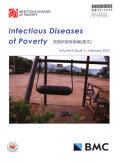- 钛学术文献服务平台 \
- 学术期刊 \
- 医药卫生期刊 \
- 内科学期刊 \
- 贫困所致传染病(英文)期刊 \
null
Assessing the nonhuman primate reservoir of Schistosoma mansoni in Africa: a systematic review
基本信息来源于合作网站,原文需代理用户跳转至来源网站获取
摘要:
Background:Reports of natural infections ofSchistosoma mansoni in a number of species of nonhuman primates (NHPs) in Africa,coupled with the substantial overlap of NHP habitats and human schistosomiasis endemic areas,has led to concerns about the role of NHPs in the transmission of human schistosomiasis.We conducted a systematic review of the literature to describe the current scope of knowledge for Africa,for the NHP species implicated,their geographical distribution,infection rates with S.mansoni,and to discuss the implications for public health and conservation.Main text:A systematic search of the literature was performed using PubMed,Web of Science,Google Scholar,the World Health Organization (WHO) library database,World Cat,and ScienceDirect without any language restriction.Studies examining S.mansoni infection of any African NHP species were included.Study types,primate species,their geographical distribution,and parasite diagnostic techniques reported in the studies were qualitatively summarized.Data for species with sample sizes >10 were included in the meta-analysis.We assessed the reported infection rate,and used a random-effects model to estimate the summary infection rates and 95% confidence intervals (C/s).We assessed heterogeneity among studies using the /2 statistics.Twenty-nine publications,from 1960 to 2018,were identified and included in the review.The studies examined a total of 2962 primates belonging to 22 species in 11 genera across ten countries (Cameroon,Eritrea,Ethiopia,Gabon,Kenya,Nigeria,Senegal,Tanzania,Uganda,and Zimbabwe),and S.mansoni infections were found in nine species of five genera in all countries.When we excluded studies with sample sizes < 10,data from 24 studies on 11 species of primates in three genera in ten countries remained in the meta-analysis.The overall pooled estimate of infection rate was 10% (95% Cl:6-1 6%) with high heterogeneity (/2 =94.77%) across countries and species/genera.Among the three genera,Pan had the highest infection rate of 15% (95% C/:0-55%),followed by Papio at 11% (95% Cl:6-18%),and Cercopithecus at 5% (95% Cl:0-14%).The association between NHP and human infections was positive,but not significant,due to low study sample matches and high variation.Conclusions:Our findings suggest that S.mansoni infection rate is high in African NHPs,with substantial heterogeneities across species/genera and countries in Africa.Given the evidence for potential spillover and spillback of S.mansoni between African NHPs and humans,further research is urgently needed to understand ecology and mechanisms of transmission of the parasite between NHP and human hosts,in order to inform control strategies of this important neglected tropical disease.

推荐文章
期刊_丙丁烷TDLAS测量系统的吸收峰自动检测
带间级联激光器
调谐半导体激光吸收光谱
雾剂检漏 中红外吸收峰 洛伦兹光谱线型
不同盐度、温度及光照对漂浮浒苔生理生态的影响
浒苔
盐度
温度
光照
生理生态
期刊_联合空间信息的改进低秩稀疏矩阵分解的高光谱异常目标检测
高光谱图像
异常目标检测 低秩稀疏矩阵分解 稀疏矩阵 残差矩阵
内容分析
关键词云
关键词热度
相关文献总数
(/次)
(/年)
文献信息
| 篇名 | Assessing the nonhuman primate reservoir of Schistosoma mansoni in Africa: a systematic review | ||
| 来源期刊 | 贫困所致传染病(英文) | 学科 | |
| 关键词 | |||
| 年,卷(期) | 2019,(3) | 所属期刊栏目 | |
| 研究方向 | 页码范围 | 10-20 | |
| 页数 | 11页 | 分类号 | |
| 字数 | 语种 | 英文 | |
| DOI | |||
五维指标
引文网络
引文网络
二级参考文献 (44)
共引文献 (14)
参考文献 (38)
节点文献
引证文献 (0)
同被引文献 (0)
二级引证文献 (0)
1960(2)
- 参考文献(2)
- 二级参考文献(0)
1969(1)
- 参考文献(1)
- 二级参考文献(0)
1970(1)
- 参考文献(1)
- 二级参考文献(0)
1972(1)
- 参考文献(1)
- 二级参考文献(0)
1975(1)
- 参考文献(1)
- 二级参考文献(0)
1979(1)
- 参考文献(1)
- 二级参考文献(0)
1982(1)
- 参考文献(1)
- 二级参考文献(0)
1989(1)
- 参考文献(1)
- 二级参考文献(0)
1991(1)
- 参考文献(0)
- 二级参考文献(1)
1992(2)
- 参考文献(0)
- 二级参考文献(2)
1993(2)
- 参考文献(0)
- 二级参考文献(2)
1994(1)
- 参考文献(0)
- 二级参考文献(1)
1995(2)
- 参考文献(0)
- 二级参考文献(2)
1997(2)
- 参考文献(1)
- 二级参考文献(1)
1998(3)
- 参考文献(2)
- 二级参考文献(1)
1999(5)
- 参考文献(1)
- 二级参考文献(4)
2000(3)
- 参考文献(1)
- 二级参考文献(2)
2001(1)
- 参考文献(0)
- 二级参考文献(1)
2002(2)
- 参考文献(1)
- 二级参考文献(1)
2003(5)
- 参考文献(2)
- 二级参考文献(3)
2004(4)
- 参考文献(3)
- 二级参考文献(1)
2005(1)
- 参考文献(0)
- 二级参考文献(1)
2006(5)
- 参考文献(3)
- 二级参考文献(2)
2007(2)
- 参考文献(1)
- 二级参考文献(1)
2008(4)
- 参考文献(2)
- 二级参考文献(2)
2009(9)
- 参考文献(1)
- 二级参考文献(8)
2010(2)
- 参考文献(1)
- 二级参考文献(1)
2011(7)
- 参考文献(4)
- 二级参考文献(3)
2012(6)
- 参考文献(2)
- 二级参考文献(4)
2013(2)
- 参考文献(2)
- 二级参考文献(0)
2015(1)
- 参考文献(1)
- 二级参考文献(0)
2016(1)
- 参考文献(1)
- 二级参考文献(0)
2019(0)
- 参考文献(0)
- 二级参考文献(0)
- 引证文献(0)
- 二级引证文献(0)
引文网络交叉学科
相关学者/机构
期刊影响力
贫困所致传染病(英文)
主办单位:
中华医学会
出版周期:
双月刊
ISSN:
2095-5162
CN:
10-1399/R
开本:
出版地:
上海市黄浦区瑞金二路207号
邮发代号:
创刊时间:
2016
语种:
eng
出版文献量(篇)
434
总下载数(次)
0
期刊文献
相关文献
推荐文献

 免费查重
免费查重










